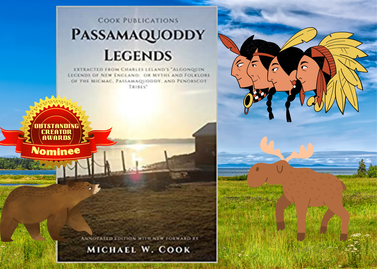|
Score: 94/100 (9.4 out of 10)
“Passamaquoddy Legends” by Michael Cook is a fun, enlightening, exciting collection of Passamaquoddy Indian stories. If there's anything we unanimously love in terms of storytelling, it's mythology. There's just something about myths and legends that's captivating. These stories are often dream-like, absurd, and typically so interesting that you can't take your eyes and ears away no matter what 'common sense' or reasons say. These Passamaquoddy Indian stories compiled and relayed by Michael Cook capture that spirit of profound enchantment and intrigue. You could imagine people gathering around the campfire telling these stories across generations. They're told in that fanciful way, pretty much like fairy-tales, even filled with fairy-like creatures and adorable personified animals. The book holds quite a unique and special place in the literary world as there aren't many well-known books about the Passamaquoddy and their culture/beliefs. Have you heard of them? There are many such books about the Cherokee and the Navajo. We've seen first-hand what can happen to a culture and a language like in Hawaii or Turkmenistan after generations of half-hearted efforts to preserve it. These older indigenous cultures are constantly in danger of being forgotten and lost to the annals of time. Books like this one are crucial to the preservation of these cultures and beliefs. Even language is preserved to an extent through this book, as terms and phrases of the Passamaquoddy are spread throughout, their significance being made known. The Passamaquoddy stories seem centered on a Herculean or Arthur-like character named Glooskap, a legendary figure whose name literally translates to “the Liar” despite him usually being seen in a heroic and positive light. He is called “the Liar” because Glooskap left the Passamaquoddy in the midst of a great struggle, promising like King Arthur or General MacArthur to return, but he has yet to return. In an almost messianic manner, he is said to be making arrows and preparing to return at the end of time for a great battle in which he'll overthrow the Iglesmani (white man). Sorry, Caucasian peeps, but the animosity the Passamaquoddy feel for the white man is very understandably. It's a tale as old as time: a better-armed imperialistic group came in and threw their weight around at the expense of the natives. We are told: “...the white man came, and with ruthless hand Cleared the forests and sowed the land, And drove from their haunts by the sunny shore Micmac and moose, forevermore.” That last line brings up another major aspect of Passamaquoddy culture, at least from what we can tell from reading these stories: their affinity for animals and nature. In this book, we see a range of stories about specific animals, not all of them necessarily viewing them in a positive light, but all of which seek to explain their specific place in the ecosystem. For example, there's an explanation for why turtles scurry into the water whenever humans are around. There are stories about wolves (the children of Lox, the villainous god), otters, rattlesnakes (“saucy Indians”), raccoons, beavers (previously “monstrous beasts” whom even Glooskap had to slay), bears (“mooin”), squirrels ("mi-ko"), sharks, black cats (“Po'guan'k”) and, probably most importantly, moose. The moose seem to have been critical to the survival of the Passamaquoddy who made homes and clothing out of their hides and ate/cooked with their tallow. Master Moose seems to hold a special place in the hearts of Passamaquoddy. There are also stories in here that are just so much fun to read, stories that are just hilarious or so absurd that they come across as hilarious and/or cute. For example, there's a story in here in which Glooskap, after just having his giant dogs fight off some other giant dogs, is congratulated with necklaces made of sausages that are in turn made of bear fat and entrails. We then get a line describing these necklaces as “garlands of enchanted sausages.” There's a story in here in which a crane—in typical male bodybuilder fashion—become narcissistic but also insecure after repeatedly getting complemented by weasels on his long legs (and probably his small calves). He becomes hungry for validation and thus vulnerable to butt-kissing by Lox, the god of mischief, who tells him his legs are well-painted. Speaking of Lox, that brings us to another major aspect of and proposition made by this book: that Passamaquoddy legends may have actually been influenced by the Vikings, presumably those from Newfoundland and/or Greenland, and possibly other white settlers they came across. Lox is very clearly Loki from Norse mythology, even having basically the same name and filling the same role. He is often also compared to Satan in Christianity. And Glooskap, as mentioned before, has a very Christ-like role in the legends, even prophesied to return in the end-times and win a great battle akin to Armageddon. Another similarity to Norse mythology is the presence of elves & fairies (“Mikumwess) or small elves (“Oonabgemessuk”). These terms for elves and fairies seems to be used interchangeably. There's also the fun and interesting use of poetic verse and songs to tell stories. For example, when the weasels tell Uncle Crane that he has great legs, they do so in song. The clams—yes, the clams—have a song. And it's adorable to imagine. Overall, this might be one of the funnest and most interesting books we've read so far this season! Check it out!
0 Comments
Leave a Reply. |
Archives
July 2024
Categories |

 RSS Feed
RSS Feed